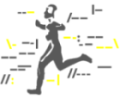





Search | Sitemap | Navigation |  |
|
||||||||||||||||||||||||||
|
||||||||||||||||||||||||||
|
||||||||||||||||||||||||||
|
| Visual hallucinations |
Visual Loss
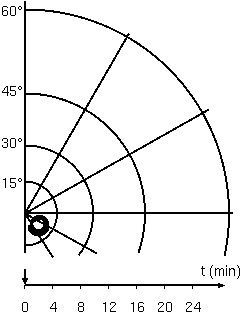
Expanding positive scotoma, reproduced from Dahlem and Müller (2003).
Fully reversible visual symptoms presenting as a transient loss of vision may occur as typical aura with migraine headache, typical aura with non-migraine headache or typical aura without headache, depending on the presence and nature of associated headache.
One can distinguish various types of visual loss.
Blurred vision is characterized by minor visual loss with a difficulty of focussing objects.
"I've had daily migraines for about 2.5 years now. Lately, within the past 3-4 weeks, I've noticed that sometimes my right eye will not focus no matter what... Sometimes I've noticed that I can't focus at all, and it makes reading impossible. I've decided that these events are auras for me -- I've never had any aura before. A few times, the eye problems have occurred *during* the headache, not before it."
(Dennis T., Newsgroups: alt.support.headaches.migraine, Subject: headaches and blurred vision, August 19, 1998)
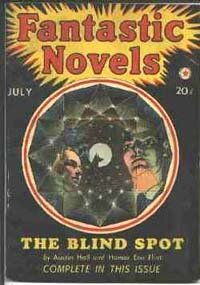
Austin Hall and Homer Eon Flint, The Blind Spot, 1921. (http://www.delos.fantascienza.com/delos58/storia-fantascienza.html, October 4, 2004)
The term scotoma refers to some form of visual loss in an area of varying size and shape - a sort of "blind spot" - within the visual field.
"I started to get a blind spot on my left side. I thought it was a migraine blind spot..."
(Martha Walz, Newsgroups: rec.running, Subject: blind spot while running?, April 10, 2001)
Absolute and relative scotomas differ in their density, the former being characterized by a complete and the latter by an incomplete loss of vision in the region of the scotoma.
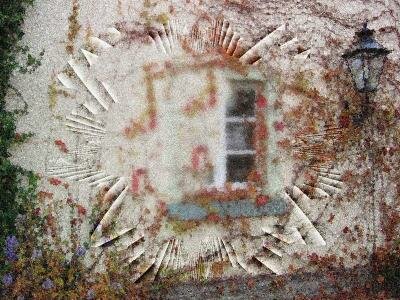
Delia Malchert, Scintillating scotoma, 2003. © 2004 Delia Malchert
Delia Malchert's illustration of her self-experienced visual migraine aura bears the typical features of a relative scotoma. "Shortly after a scintillating scotoma, which I experienced on New Year's eve 2003", she recalled, "I produced from very fresh memory a computer graphic representation. It shows the partial defect of the visual field [i.e. relative scotoma], which I didn't manage to represent satisfactorily in my previous pictures." [more]
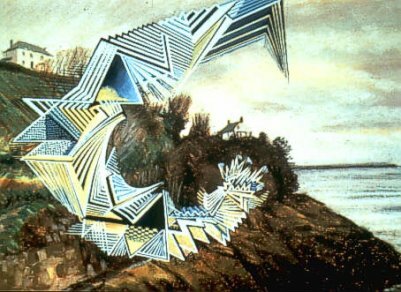
Entry to art contest Migraine Images, 1992. © 2005 GlaxoSmithKline
Roger Heaton's entry to the 1992 Migraine Images art contest shows a C-shaped visual migraine aura completely obscuring the artist's view of a landscape, i.e., an absolute scotoma.

Entry to art contest Migraine Images, 1992. © 2005 GlaxoSmithKline
The following is a report of a complete loss of the left half-fields of vision, i.e. absolute hemianopia: "During an ophthalmic migraine, my experience has usually been losing half the vertical vision. So if I were looking at a face I would see one side and not the other. (But I've had your pattern as well.) My first recognizable migraine began while driving with my children in the car on a curved parkway. I could not see any oncoming traffic, only the right side of the road."
(Judy, Newsgroups: alt.support.headaches.migraine, Subject: How about this Migraine site?, January 22, 1998)
The distinction between a negative and a positive scotoma, as first defined by the German ophthalmologist Richard Foerster in 1871, is frequently misunderstood. If the vision is absent in the area of the scotoma, often described as a blank, a void, an emptiness or nothingness, it is called a negative scotoma. If the vision is enhanced or enriched, so that the blind spot is experienced as an area of darkness, as a blackness, as a light or as an area comprising hallucinatory patterns, like a positive void, it is labelled a positive scotoma.
Negative scotoma: "You don't see blackness... you don't 'see' anything""Also, all my life I have suffered with what is called 'occular migraines'. They are a very strange kind of migraine for the most part. I usually don't get more than about three or four per year...so, no big deal. Unless, you are knee deep in a tennis match!!! For those of you who don't know what an occular migraine is I will tell you. When they first come on or start they are actually pretty fantastic. You all of a sudden start seeing the most beautiful auras...colors of lights...flashing around in random patterns. These patterns zig-zag super fast with every color in the rainbow. It's almost like watching a July 4th fireworks display. While the auras are subsiding you go basically blind. You lose your part or all of your vision. The blindness usually moves across your eyes until you see absolutely nothing. Now for those of you who think blindness is the same thing as seeing blackness when you close your eyes - you are completely wrong. Blindness is like trying to see and there is nothing registering with the brain. You don't see blackness... you don't 'see' anything. The sense to see is gone. This blindness or partial blindness can last from 15 minutes to up to two or three hours. Nothing you can do but wait it out. Once, your vision returns you have the most pounding headache you can imagine... nausea, etc." (Gary, Newsgroups: rec.sport.tennis, Subject: Occular Migraine...talk about focusing on the ball, November 20, 2003) |
The term scintillating scotoma refers to the pulsating movements of the hallucinatory patterns appearing on the border regions of a negative or positive scotoma. Thus, a scintillating scotoma either combines the features of a negative and a positive scotoma, qualifying as the latter because of the hallucinatory patterns at its margins, or it displays in its entirety the features of a positive scotoma.
A vivid description of the pulsating movements of SS: "I had the strangest thing happen at work today and really need to touch base with anybody who has experienced something similar. The extent of my 'auras' are usually just a few little flashes. Today was very different and it lasted about ten minutes. Try to picture this, if you can: The lights above me seemed to be flickering and flashing in both eyes. While trying to see with my right eye, it was like I was under water, looking up with good vision through a small round hole, and yet all around it was all this activity, like waves, flashing, flickering, a little foggy. It was like part of my eye was under water and the rest looking right through the top."
(Sage, Newsgroups: alt.support.headaches.migraine, Subject: Alice in Wonderland syndrome, November 1, 2005)
An example of SS combining features of negative (white outs) and positive scotoma (jagged line): "I was finished with patients recently, and sat down at my desk and as I spoke with several staff members, I commented that it felt like I had just looked at the sun as I had several white outs in my visual field. I could not see the full face of the assistant in the room. I thought it would clear, but in about 5 to 7 minutes, it progressed to a multicolored jagged line primarily in the left lateral portion of my left eye and I could see a dimmer identical jagged line in the left portion of my right eye. As I was looking up the number for my opthomologist, the left portion of my left eye became a half moon fluttering wave-like image. My vision in the right eye was unaffected except for the small jagged line... My vision began to clear within 2 or 3 minutes and the physician called back and told me she 'knew exactly what it was' and this is my first exposure to ss."
(Samantha, Edith Frost's Homepage, June 20, 2004)
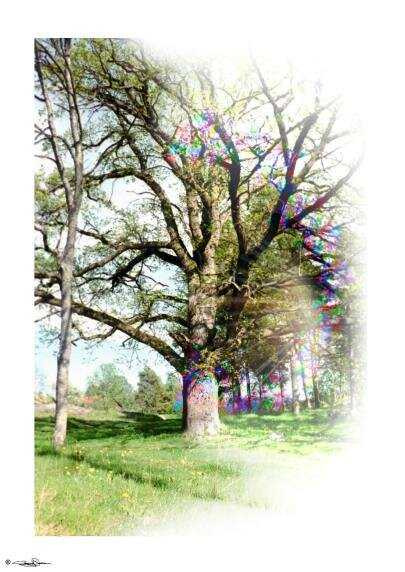
Conny K. Jonsson, Untitled, 1999. © 2004 Conny K. Jonsson
Another example of SS presenting with features of both positive and negative scotoma is provided by the image from Conny K. Jonsson: "A picture that I made some years ago", he wrote, "will show my visuals quite accurate, I think. It always starts as a small spot in the focus and 'grows' until it disappears in the periphery. The whiteness (to the right) is ... nothing ... just blindness." [more]
(Conny K. Jonsson, Email to Klaus Podoll, October 9, 2002)
An example of SS displaying exclusively features of a positive scotoma (grey hole + jagged edges): "Just had my 2nd SS after a break of several months.... My first experience was like watching an irregular shaped grey hole just off centre in my field of vision. The edges were jagged and 'shimmering' and over a 20 minute period the shape grew larger as though it were travelling towards me, and finally seemed to pass by me, almost as though I physically passed through its centre. Really spooky. There was no pain but I felt a little weird."
(Cheryl Fox, Edith Frost's Homepage, July 20, 2004)
A similar example can be seen in the following animated illustration reproduced by courtesy of David C. Haas, MD.
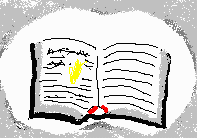
Visual migraine aura with herringbone pattern and [positive] scotoma. (David C. Haas, Headache Cybertext, Lost webpage April 29, 1999; reproduction by courtesy of David C. Haas)
Ocular migraine development narrative"As I am writing, I am undergoing an episode of ocular migraine. I became aware of it earlier than usual. I was reading and found that the reading portion of my bifocal was not working well and letters appeared blurry. At first I thought that my cataract was much worse, but it just happened too fast. Taking my glasses off helped somewhat. After about five minutes, there were gaps in my field of vision. After ten minutes, I began to notice small areas with the typical zig-zag lines of ocular migraine but without the parallel striations I often see. At 15 minutes, the aura had greatly increased in size. At 20 minutes, it was of maximum size. At 25 minutes it was gone. It is now about 30 minutes after I first noticed it. The aura appears to be completely gone. Nevertheless, I do not feel completely recovered yet." (Bill, Newsgroups: sci.med.vision, Subject: Ocular migraine development narrative, June 29, 2001) |
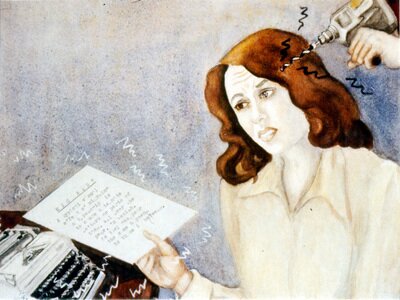
Migraine Art: Asthenopic scotoma. "A typical visual effect of migraine in typescript is to cause alternate letters or parts of them, all over the page, to vanish. As they reappear the same happens to those in between." © 2005 Migraine Action Association and Boehringer Ingelheim Limited
An asthenopic scotoma is a scotoma with an asthenopic mode of presentation, characterized by an abnormal fatiguability of visual function and manifesting itself as the disappearance of part or whole of a visual target after a latent time.
References
Dahlem MA, Muller SC. Migraine aura dynamics after reverse retinotopic mapping of weak excitation waves in the primary visual cortex. Biol Cybern 2003; 88: 419-424. [PDF]
Foerster R. Lichtsinn bei Krankheiten der Chorioidea und Retina. Klin Mbl Augenheilk 1871; 9: 337-346.
Klee A, Willanger R. Disturbances of visual perception in migraine. Acta Neurol Scand 1966; 42: 400-414.
Author: Klaus Podoll
Last modification of this page: Monday March 21. 2005
| Visual hallucinations |
 Top of the page
Top of the page| · | News |
| · | Medical Professionals |
| · | Medical Studies |
| · | Conny K. Jonsson |
| · | Delia Malchert |
| · | Model of traveling scotoma |
Copyright © 2005 Migraine Aura Foundation, All rights reserved. Last modification of this site: August 25, 2006
Thanks to: RAFFELT MEDIENDESIGN and GNU software | webmaster@migraine-aura.org
http://migraine-aura.org/EN/Visual_Loss.html
